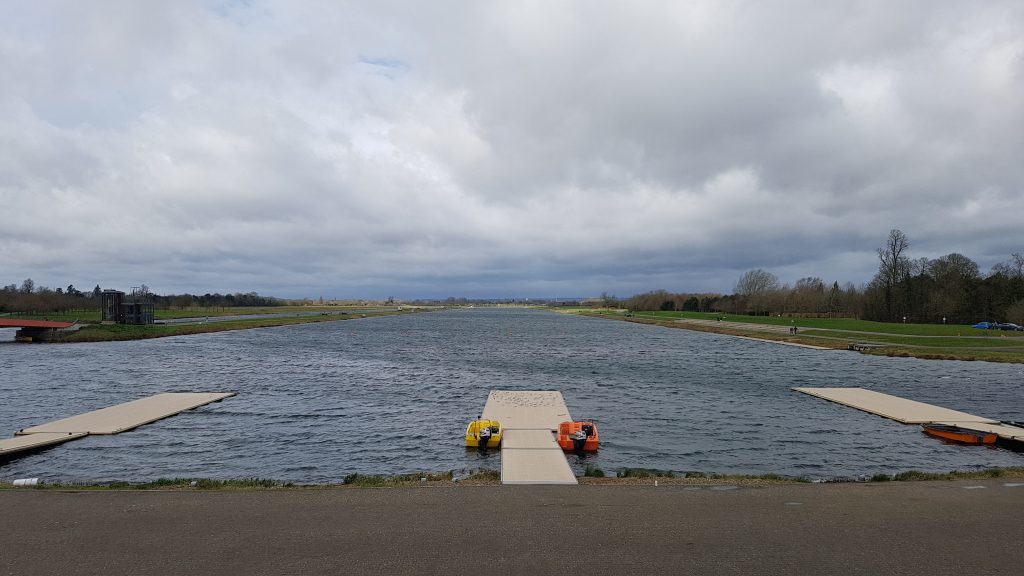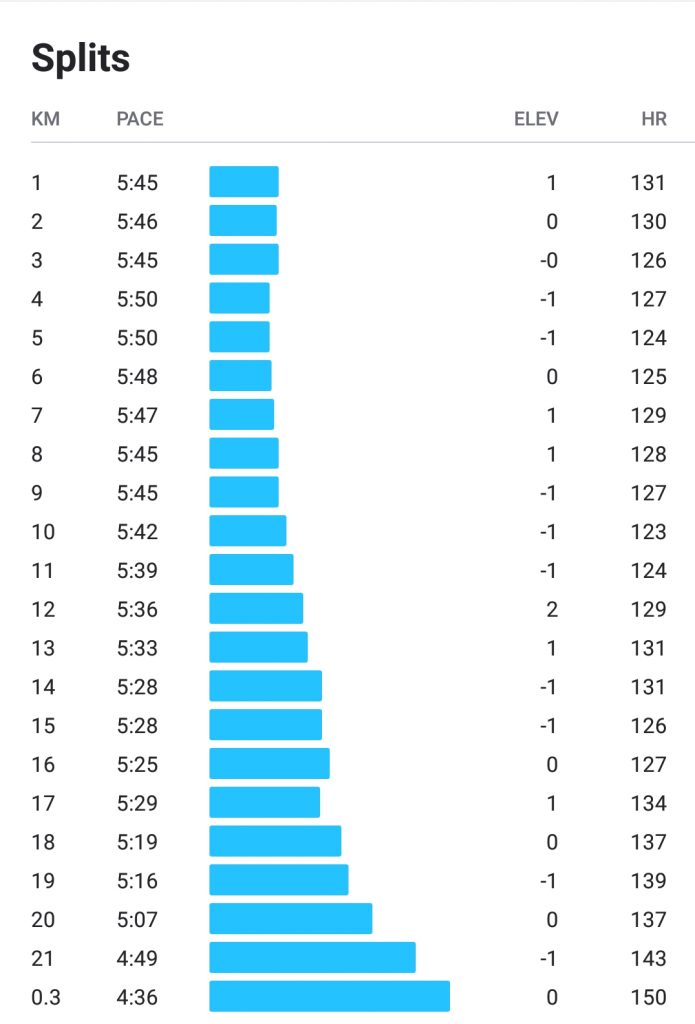Week 8 of my 16-week marathon training plan had a half-marathon race, and I’d chosen Dorney Lake. This is only a small race, but is simple, almost flat, and I hoped would give me what I needed – a little bit of atmosphere, something different from an ordinary training run to test myself a bit, after only short runs at speed, and long runs all being slow or at most “easy”.
Two Sundays ago we had Storm Ciara, and I lurked on the treadmill; one Sunday ago we had Storm Dennis, and I lurked on the treadmill. So I had watched the weather forecast with some trepidation for several days. The wind, which has barely dropped below 20mph (gusting to 40mph) for more than two weeks, with yet more rain, looked likely to put a damper on things, though by Saturday the forecast was hinting that the worst of the rain would be out of the way by the time we got underway.
Sunday morning dawned wet and windy, but by the time I arrived at Dorney Lake, the rain had stopped, and baring a little bit of drizzle, mercifully stayed away for the rest of the morning. However, when I got out of the car, I was pushed across the car park by the strong wind, and yet another factor joined the mix in my pace puzzle.
The Pace Puzzle
- I’ve set a goal of sub-4h30 for the marathon. My favoured running calculator says that’s equivalent to being able to run 2h03 for a half-marathon – or 5:50/km
- My best recent 10km is 53:46, nominally equivalent to a 1:58:45 half marathon – or 5:38/km
- My training plan said to aim for sub-2h06 – or 5:58/km, and 2h03 in a fortnight.
- I am not a sprinter, but have always tended to underperform at longer distances compared to what I “should” achieve – my 10km time is relatively slightly poor given my 5km time; my half-marathon is relatively poor given my 10km time
- If you start too fast, then in a long run, by the time you realise it is too fast to maintain the pace throughout, you are in deep trouble
- I wanted to test myself and find out how my training is going – that is a key reason for being here.
- I was going to be wearing my Vaporfly trainers for the first time in a race
- It was extremely windy
I’d arrived intending to go for 5:50/km, but when I experienced the wind, I moderated that to 6:00/km, adjusted back to 5:59/km because that would be psychologically more satisfying.
The preparations
I walked to the boathouse and got my race number. I explored the facilities including changing rooms, then went back to the car to finish getting ready – pin my number on, remove excess clothing, put on running trainers, add heart-rate chest strap, put on bumbag with gels, take caffeine tablet, finalise pre-race nutrition, and keep well hydrated.
For a 9.45am start, I wandered back to the boathouse at about 9.25am, feeling somewhat self-conscious in my pink Vaporflys – I couldn’t immediately see any others in evidence around me. As well as being pink, they do keep reminding one of their presence as they are so bouncy compared to normal shoes.
I went for a warm-up jog of a few hundred metres, then we assembled for a short pre-run brief, and moved to the start line. I chatted to a couple of people who were running a shorter distance (there was a 5k and 10k starting at the same time), and spotted one other person in Vaporflys, albeit green ones.

The race
And, at 9.43am, we were off. The route for the half-marathon was four laps around the Olympic rowing lake – the “up” being along a winding lane with glimpses of the Thames through trees to the left, and at times quite a gap to the lake – almost the feel of a rural lane, with no traffic, just the occasional dog-walker or small family group, some waterfowl, and at one point a small herd of deer running across the lane. Although the wind was blustery and somewhat variable in direction, it was mostly a headwind along this section. At the end we reached the top of the rowing lake; on the first lap there was an extra out-and-back to make the maths add up with the otherwise 5km laps used for the 5k and 10k races. The very windy out-and-back completed, it was a straight run alongside the 2.2km or so of the rowing lake, crossing three bridges, to return to the start, with the wind somewhat from my right, and somewhat behind me, hopefully returning some of what I’d lost into the headwind. So far, so good, and I found I was going a little faster than recent plans, around 5:48/km, but consistent with the original plan.
The second lap went well. I’d had a little pain/discomfort in my insteps on the first lap, something I’ve not really had trouble me before, and I worried it might be the new shoes, but it passed after about 3km, and now fully warmed up, I felt my legs moving freely. On the outward part of the lap, I had to constrain myself a little to avoid speeding up, and as I return back along the lake, I decided that I was going to maintain the pace until the end of lap 2, then try a little acceleration.
Having done lap 1 at 5:48/km, and lap 2 at 5:44/km, I had the odd sensation of feeling fresher as time went by, and I found lap 3 completed at 5:29/km, with my eye now very much on the average pace – I knew that if I got it under 5:41/km I would be under two hours, though I had a suspicion that the course might measure slightly long on my Garmin.
I was still holding myself back, but let my legs accelerate a bit more on the outward section of lap 4, as the wind intensified further. I managed finally to overtake three people who I’d had in my sights for 10km. At the top, I turned for home. Having run the 18th and 19th kilometres at 5:19 and 5:16 into a headwind, I now had the benefit of the wind behind me, and the 20th and 21st kilometres were at 5:07 and 4:49, with the last section at 4:36. I was helped somewhat by the wind, but the feeling of energy in the legs after 20km was remarkable. Although the Vaporflys are said to benefit all speeds of runners, perhaps this was when they really came into their own, when I was properly running rather than what the elites would consider a jog – certainly towards the end, my cadence was up and my stride length was up, but I felt less tired than after a full-effort parkrun.
And so I crossed the line in an official time of 1:58:18, or 5:33/km on my Garmin distance of 21.3km. That was significantly better than planned, despite windy conditions. The second half of my race was 4½ minutes faster than the first half, which is a significant negative split. It’s my 4th fastest half-marathon (with the smallest field, of only 100), and 3rd fastest 15km within that – very satisfying in its own right, and as a step towards Boston. I’m currently carrying a fair bit of extra weight – if one were to produce a weight-adjusted time, then this would be a personal best time.
The aftermath
After catching my breath, collecting some water and jelly babies, and picking up my bag, I went upstairs and had a shower and put on some clean clothes – a really civilised thing to be able to do after a race.
The pace puzzle will return in 13 days, when I decide, in the light of today, how I should pace my next half-marathon. But in the meantime, my running calculator says 1:58:18 is equivalent to 4:19:05 for the marathon – I’m not expecting that time, but it gives me a little more confidence that sub-4h30 may be within my grasp.
And the impacts afterwards – no digestive distress at all, no toe pain or blistering at all, no muscle-soreness at all, and my mild knee pain no worse than usual. Probably the least impact after a half-marathon race or any run of this distance. I even had the energy to take six dogs for an hour’s walk in the forest when I got home.
Is it the shoes? Is it the different training (more distance, less speed)? Who can say? But looking good so far…


One reply on “Dorney Lake Half-Marathon”
[…] for sub-2h03 today, as being broadly equivalent in effort to my 4h30 marathon objective. After the success of the race at Dorney Lake, I’d decided to aim for sub-1h57, to beat the Dorney Lake time of 13 days earlier by two […]